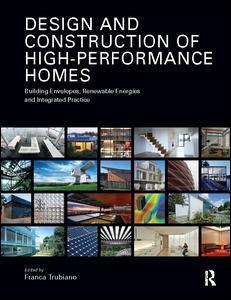Description
Design and Construction of High-Performance Homes
Building Envelopes, Renewable Energies and Integrated Practice
Coordinator: Trubiano Franca
Language: English
Subject for Design and Construction of High-Performance Homes:
Keywords
Trubiano; trubiono; franca; home; designing; Ground Heat Exchanger; house; Super Critical; National Green Building Standards; Google Power Meter; Common Language; High Performance Homes; Energy Recovery Ventilator; Energy Balance; IDP; Evacuated Tube Collectors; High Performance House; Project Icarus; Solar Heat Gain; SIPs; Utility Core; ETFE Roof; BIM; Exterior Shades; North House; Modular Building; PCM Material; Parametric Design Environment; Sun Control; AEC Industry; Ultra-HighPerformance Concrete
Publication date: 06-2017
· 18.9x24.6 cm · Hardback
Publication date: 11-2012
288 p. · 18.9x24.6 cm · Paperback
Description
/li>Contents
/li>Readership
/li>Biography
/li>
Both professionals and students are increasingly committed to achieving high-performance metrics in the design, construction and operation of residential buildings. This book responds to this demand by offering a comprehensive guide which features:
- architectural innovations in building skin technologies which make lighter more transparent buildings high performing
- energy-free architectural design principles and advances in building-integrated photovoltaics
- essential engineering principles, controls and approaches to simulation for achieving net zero
- the advantages of integrated design in residential construction and the challenges and opportunities it engenders
- detailed case studies of innovative homes which have incorporated low-energy design solutions, new materials, alternative building assemblies, digital fabrication, integrated engineering systems and operational controls.
Divided into four parts, the book discusses the requisite AEC (Architecture, Engineering and Construction) knowledge needed when building a high-performance home. It also communicates this information across four case studies, which provide the reader with a thorough overview of all aspects to be considered in the design and construction of sustainable homes. With contributions from experts in the field, the book provides a well-rounded and multi-faceted approach.
This book is essential reading for students and professionals in design, architecture, engineering (civil, mechanical and electrical), construction and energy management.
Introduction: Household Power: How Much is Enough? Part 1: Building Envelopes, New Materials and Architectural Design 1.1. Energy Free’ Architectural Design – The Case of PassivHaus and Double Skin Facades 1.2. Translucent Building Skins – Advancing the Technology of Light Transmission 1.3. Responsive Building Envelopes: Characteristics and Evolving Paradigms 1.4. Nano-Materials + Bio Insulators + Phase Change Materials Part 2: Renewable Energies, Building Systems and Simulations 2.1. The Design Integration of Renewable Energies 2.2. Systems Integrated Photovoltaics, SIPV 2.3. Building Systems, Controls and Automation 2.4. Building Performance and Computational Simulation Part 3: Integrated Practice and Residential Construction 3.1. Integrated Project Delivery – Contracting for High Performance 3.2. Energy and the Integrative Design Process, Defining the Team of Experts 3.3. The Construction of Low Energy Prefabricated Housing in Denmark 3.4. From Modeling to Making, Parametric Design and Digital Fabrication Part 4: High Performance Homes: Case Studies 4.1. LumenHaus and the Eclipsis Sun Control System 4.2. Project Icarus: Optimizing Light and Energy in the Design of a Translucent Roof 4.3. North House: Climate Responsive Envelope and Control System 4.4. Modular Building; Three Scales/Three Strategies
These books may interest you

Bioclimatic Double-Skin Façades 209.69 €



